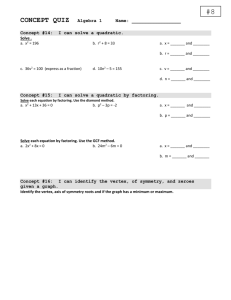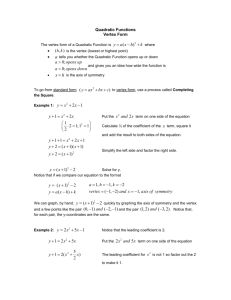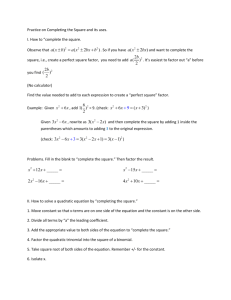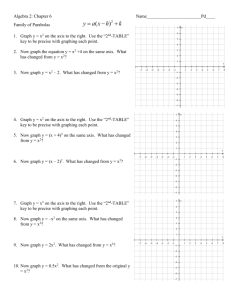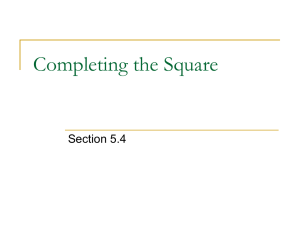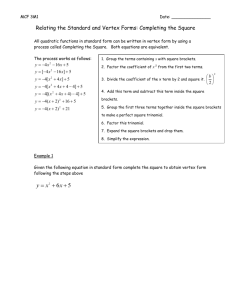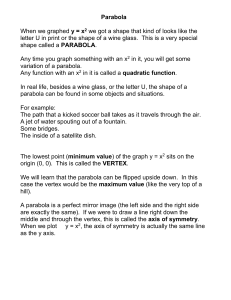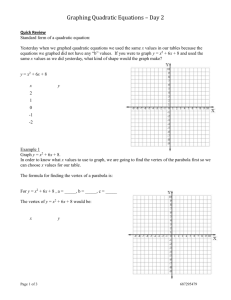Quadratic Functions
advertisement
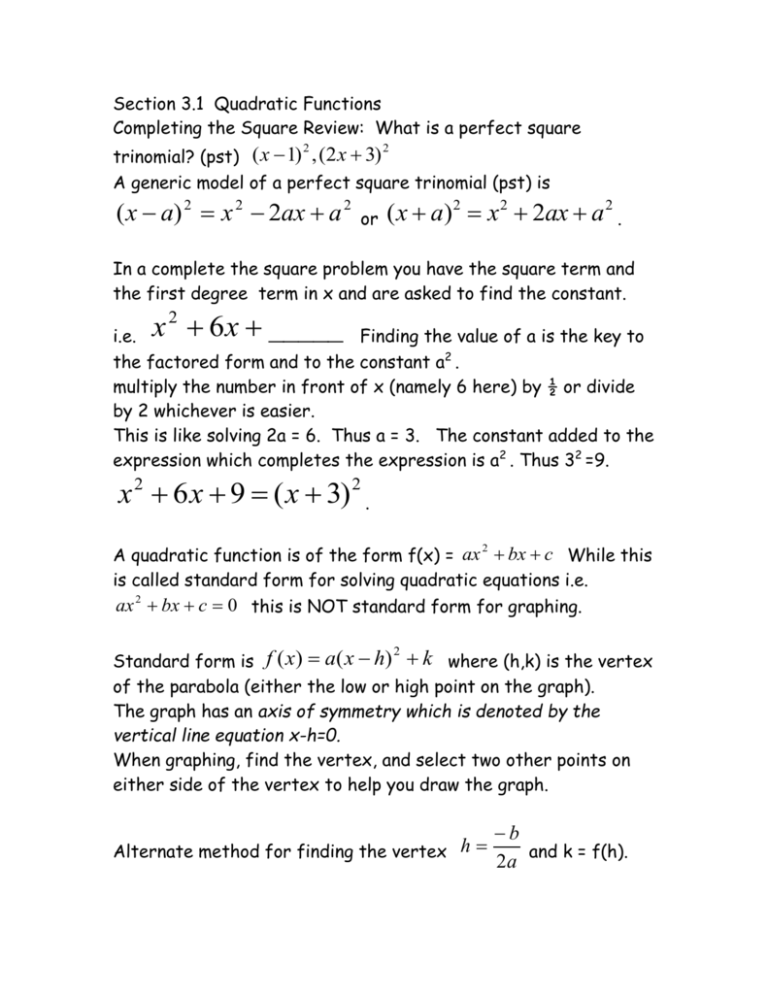
Section 3.1 Quadratic Functions
Completing the Square Review: What is a perfect square
trinomial? (pst) ( x 1) , (2 x 3)
A generic model of a perfect square trinomial (pst) is
2
( x a) 2 x 2 2ax a 2
2
or
( x a)2 x 2 2ax a 2 .
In a complete the square problem you have the square term and
the first degree term in x and are asked to find the constant.
2
i.e.
Finding the value of a is the key to
the factored form and to the constant a2 .
multiply the number in front of x (namely 6 here) by ½ or divide
by 2 whichever is easier.
This is like solving 2a = 6. Thus a = 3. The constant added to the
expression which completes the expression is a2 . Thus 32 =9.
2
2
.
x 6 x _____
x 6 x 9 ( x 3)
A quadratic function is of the form f(x) = ax bx c While this
is called standard form for solving quadratic equations i.e.
2
ax 2 bx c 0 this is NOT standard form for graphing.
Standard form is f ( x) a( x h) k where (h,k) is the vertex
of the parabola (either the low or high point on the graph).
The graph has an axis of symmetry which is denoted by the
vertical line equation x-h=0.
When graphing, find the vertex, and select two other points on
either side of the vertex to help you draw the graph.
2
Alternate method for finding the vertex h
b
and k = f(h).
2a
Example 1: Find the vertex and axis of symmetry for the
following parabola, and write the parabola equation in standard
form.
f ( x) x 2 8x 15
Finding the vertex by completing the square:
Using only f ( x) x 8 x
Let 2a=8 then a = 4 and a2 = 16
2
Thus
f ( x) x 2 8x 15
f ( x) x 2 8x 16 16 15
You add and subtract 16
which is like adding zero.
Then factor the first three terms into the perfect square
trinomial (pst)
f ( x) x 2 8 x 15
f ( x) x 2 8 x 16 16 15
f ( x) ( x 4) 1
2
{which gives us the standard form
for this expression}
Thus h = - 4 and k = -1 (-4,-1) is the vertex. And x+4=0 is the
equation of the axis of symmetry.
Alternate method of finding the vertex: f ( x) x 8 x 15
2
h
b
2
where a = 1 and b = 8 (going back to ax bx c ) h = 2a
8/2(1) = -4
f(h) = k thus 4 8(4) 15 16 32 15 1
Putting this information into the standard form for the equation
2
of a parabola f ( x) a( x h) k
2
f ( x) 1x (4) 1 ( x 4) 2 1
2
Example 2: What to do for the general quadratic.
f ( x) 2 x 2 16 x 31
Remember in completing the square if the squared term had a
number other than 1 you had to divide by that number. Since this
is not strictly a solving equation we have to do something slightly
different.
We factor out whatever the number is i.e. f ( x) 2( x 8 x) 31
but just from the squared term and the first degreed term. If
the first degreed term were 17 instead of 16 then it would be
(17/2) x.
2
f ( x) 2( x 2 8x) 31 We complete the square on what’s inside
the parenthesis. Thus ½ (-8)=-4 and (-4)2 =16 giving
f ( x) 2( x 2 8x 16) 31 32 [The –32 comes from the fact
that we added 2(16) to the problem so we subtract the same
amount to equal 0]
f ( x) 2( x 4) 2 1 and the vertex is (4,-1) the axis of symmetry
is x-4=0
if we used the alternate form to find h and k, h = -(-16)/2(2)=
16/4= 4
f(4) = 2(16) –16(4) + 31= 32 – 64 + 31 = -1
To find the intercepts use the original equation. To find the x
intercepts set f(x) = 0 and solve.
2 x 2 16 x 31 0
x
16 256 4(2)(31)
2 ( 2)
16 8
4
16 2 2 8 2
x
4
2
x
and x = 4.7 y = 0 or x = 3.29 y=0
To find the y intercept let x = 0 then y = 31

